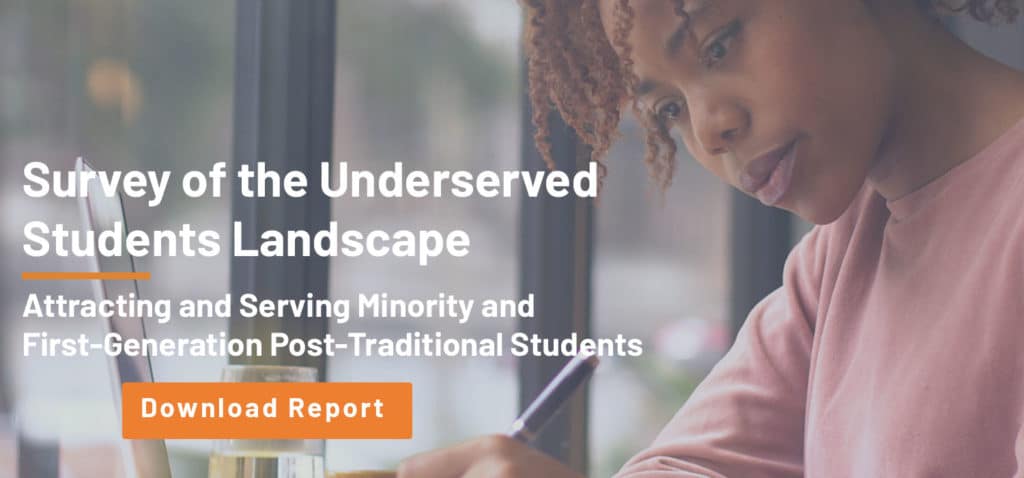Survey of the Underserved Students Landscape

EducationDynamics latest report, Survey of the Underserved Students Landscape, uncovers how to best target, reach and engage minority and first-generation students and how to grow enrollments amongst underserved students. The report uncovers how minority and first-generation students are motivated by career advancement and other factors, dissects enrollment obstacles, and explores the value of prior learning credit. To get a better understanding of how colleges and universities can reach and support historically underserved student populations, we surveyed adult students that self-identified as minority students or the first in their family to attend college and who have enrolled in college in the past 3 years or were starting college in the fall of 2020. These undergraduate students were most likely to pursue a Bachelor’s degree, but were also interested in Associate’s degrees, non-credit certificates and stackable micro-credentials.
From our research, first-generation students are more likely to have a gap between completing high school and their initial higher education enrollment. Amongst these students, nearly 22 percent indicated that they waited more than five years after high school to enroll in higher education. 31 percent of African-American and 25 percent of Latino students waited more than five years to reenroll in higher ed programs.
Career-related focuses and challenges significantly impact enrollment among students from underserved populations. Across the board, career and income motivations were reported as the primary motivations for pursuing a degree; 96 percent enroll for career-related reasons — their primary motivation– and 50 percent cited a career or income centered action as their clarion call to enroll in higher education when they did.
Additionally, these students expect to see near-term outcomes. Nearly two-thirds of survey respondents expect to see outcomes within six months of beginning their program and 41 percent indicating that the most important factor when selecting a program was how quickly it could be completed.

Speed to completion plays an important factor in program selection for minority and first-generation students. Not surprisingly, respondents also indicated that they were interested in alternative paths that increased speed to completion. Nearly half of survey respondents, 47 percent, indicate that they received credit for prior learning. Of those who did not receive any credit for prior learning, 77 percent indicate it would be attractive to them and 77 percent indicate it would be helpful in completing their program.
Nearly all respondents found stackable certificates to be attractive, including 55 percent who found them to be very attractive. Colleges and universities offering stackable certificates should emphasize their availability and communicate how these credits improve time to completion.
Interested in learning more about the Survey of the Underserved Students Landscape report? Download the report now to discover how to best serve and support minority and first-generation students.
EducationDynamics is the industry leader in helping colleges and universities achieve their enrollment goals through the company’s unique ability to find the highest quality adult student prospects. As the trusted partner to more than 700 higher educational institutions, EducationDynamics has earned a reputation for providing the resources and expertise required to meet a wide range of industry challenges, delivering inquiry generation and agency of record marketing (e.g. paid digital, organic search, awareness), enrollment management, retention, and technology solutions to universities across the country. For more information, visit: educationdynamics.com